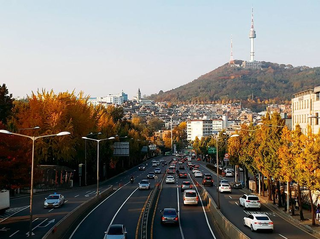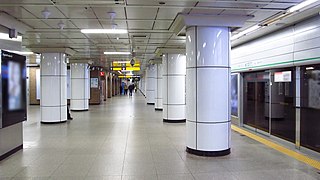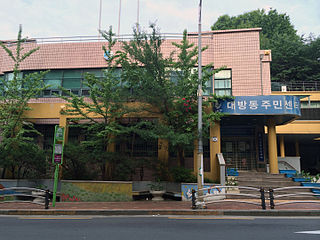Related Research Articles

Yongsan District is one of the 25 districts of Seoul, South Korea.

Sadang Station is a station on the Seoul Subway Line 2 and Seoul Subway Line 4 in South Korea.
Yuhan Corporation is a South Korean pharmaceutical and chemical company headquartered in Daebang-dong, Dongjak-gu, Seoul. It was established in 1926 by New Il-han and has been listed on the Korea Stock Exchange since 1962. Yuhan is one of the top Korean pharmaceutical companies, along with Celltrion, Samsung Biologics, GC Pharma, and Hanmi Pharmaceutical.

Yeongdeungpo District is an administrative district in southwest Seoul, South Korea. Although the origin of the name is uncertain, the first two syllables are thought to be from "yeongdeung" (靈登) or "divine ascent", a shamanic rite. The third syllable is "po", representing the bank of a river (浦), referring to the district's position on the Han River. The 2006 population was 408,819.
Yu Seong-won was a scholar-official of the early Joseon Dynasty, who is remembered as one of the six murdered ministers. He was born to a yangban family of the Munhwa Ryu lineage, but his date of birth is not known.

Gwanak District is an administrative subdivision (gu) of Seoul, South Korea. It lies on the southern skirt of Seoul, bordering Anyang of Gyeonggi Province. The southern border of Gwanak District, bordering Anyang, consists of the craggy ridgeline of Gwanaksan, which dominates the local geography.

Seocho District is one of the 25 local government districts which make up the city of Seoul, South Korea. Seocho is a part of the Gangnam region, along with the Gangnam district of Seoul. Seocho District ranks as one of the richest neighborhoods in South Korea and among the most expensive areas in Seoul with an average sales price of 47.75 million South Korean won per 3.3 square meters. Many of the wealthiest residents are concentrated in the three Gangnam districts including Seocho, known as Gangnam School District Eight.

Dongjak District (Korean: 동작구) is one of the 25 gu (districts) that make up the city of Seoul, South Korea. Its name was derived from the Dongjaegi Naruteo Ferry, on the Han River which borders the district to the north. It was the 17th gu created in Seoul, after being separated from Gwanak District on 1 April 1980.

Noryangjin Station (Korean: 노량진역) is a metro station in southwest region of Seoul, South Korea. The station is located in the Noryangjin-dong (neighborhood) of Dongjak-gu (ward) and is also a stop on Seoul Subway Line 1 and Seoul Subway Line 9. This stop is a popular destination for those seeking to eat raw fish, and other assorted seafood, as a large, covered sea food market is located next to the station, accessible by foot bridge. The Line 1 station is also notable in that Exit 1 and 2 have the same number as Exit 1 and 2 of Line 9's station.
Bon-dong is a dong (neighborhood) of Dongjak District, Seoul, South Korea.

Daebang-dong is a dong (neighborhood) of Dongjak District, Seoul, South Korea.
Dongjak-dong is a dong (neighborhood) of Dongjak District, Seoul, South Korea.
Noryangjin-dong is a dong (neighborhood) of Dongjak-gu in Seoul, South Korea.

Sadang-dong is a dong (neighborhood) of Dongjak-gu in Seoul, South Korea.
Sangdo-dong (Korean: 상도동) is a dong, neighbourhood of Dongjak District in Seoul, South Korea.

Noryangjin Fisheries Wholesale Market or shortly Noryangjin Fish Market is an extensive farmers fish market in the neighborhood of Noryangjin-dong in Dongjak District, Seoul, South Korea. It is located east of 63 Building, and just south of the Han River. Metro line 1 passes through at Noryangin station near-by. Exit the station at exit 1 and walk under the bridge. It is open 24/7.
Siheung County, alternatively Shihŭng County was a county (gun) in Gyeonggi Province, South Korea. This county was abolished in 1989 as its one town(읍) of Sorae and two townships(면) of Gunja and Suam became Siheung City at the same time. Today's Siheung City area did not belong to Siheung County before 1914. The area rather was part of old Incheon or Ansan.
Wa-dong is neighbourhood of Danwon-gu, Ansan, Gyeonggi Province, South Korea. It is located in Gwangdeoksan Mountain, a famous tourist attraction in Ansan, a sports park and a driver's license test site, a public cemetery, exclusive soccer, badminton, and basketball courts, so sports facilities and parks are in good harmony. Hwajeongcheon Stream flows outside the east, but an undeveloped mountain blocks the center, dividing the living area. It consists of a housing type in which single-family households such as multi-family and multi-family households are more than 90%, and low-income families with 80% of tenants mainly live. It is an area in urgent need of redevelopment as nine distribution stores, the largest commercial site in the jurisdiction, are stagnating due to their small size.

Boramae Park Station is a station on the Sillim Line. It is located in Sindaebang-dong, Dongjak District, Seoul.

Boramae Park is a large public park in Sindaebang-dong, Dongjak District, Seoul, South Korea.
References
- 1 2 "신대방동 (Sindaebang-dong 新大方洞)" (in Korean). Doosan Encyclopedia . Retrieved 2008-04-17.
